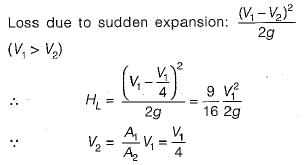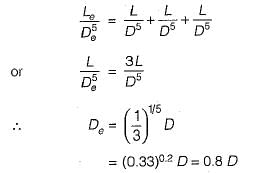Test: Flow Through Pipes - 1 - Mechanical Engineering MCQ
10 Questions MCQ Test Fluid Mechanics for Mechanical Engineering - Test: Flow Through Pipes - 1
If a set of pipes described by (L1 D1,f1), (L2, D2, f2)... are connected in series then an equivalent pipe (Le, De, fe) is related as
If a set of pipes described by (L1 D1,f1), (L2, D2, f2)... are connected in parallel between two points, then an equivalent pipe (Le, De, fe) is related as
The head loss in a sudden expansion from 5 cm diameter to 10 cm diameter pipe, in terms of velocity V1 in the 5 cm pipe
In a sudden contraction, the velocity head changes from 0.5 m to 1.25 m. The coefficient of contraction is 0.66. The head loss in this contraction is
The loss at the exit of a submerged pipe in a reservoir is
A pipe has a well rounded entrance from a reservoir. If the head loss at the entrance is expressed a the value of K would be about
the value of K would be about
In a 15 cm pipe line, the minor losses add upto  The length of a pipe of 15 cm diameter 2fif {f = 0.03) equivalent to this loss is
The length of a pipe of 15 cm diameter 2fif {f = 0.03) equivalent to this loss is
Three identical pipes of lenght L, diameter D and friction factor f, are connected in series between two reservoirs. The size of a pipe of length L and of the same friction factor f, equivalent to above pipeline, is
Two pipe systems in series are said to be equivalent when
|
56 videos|106 docs|75 tests
|























